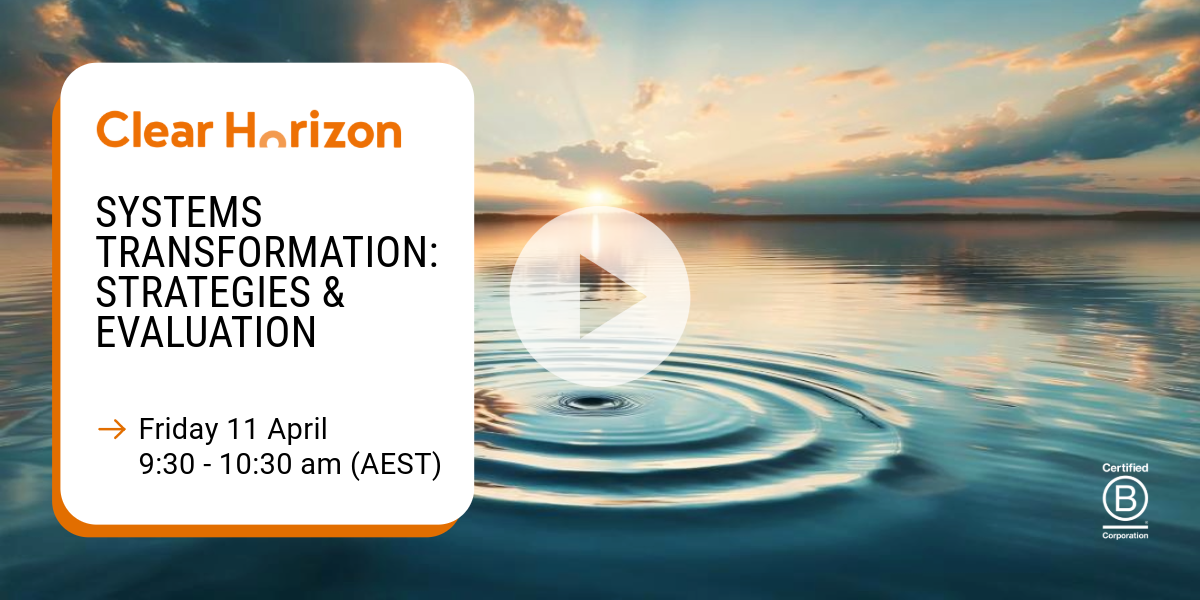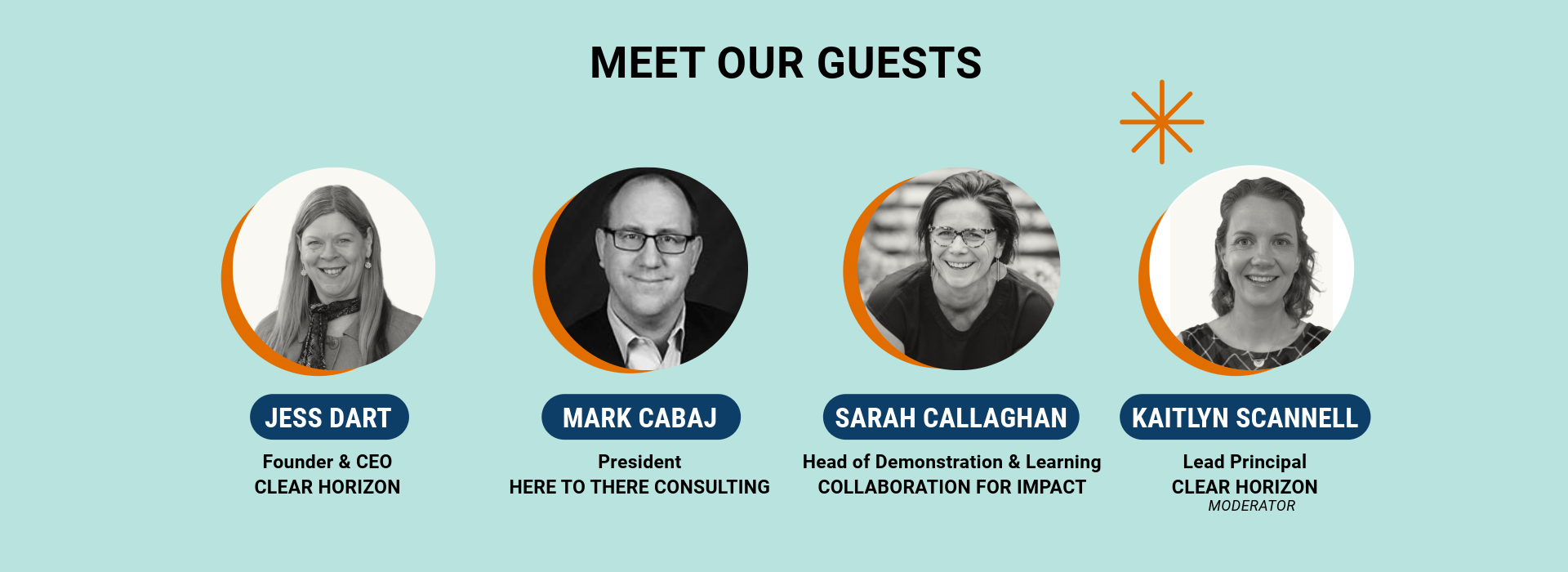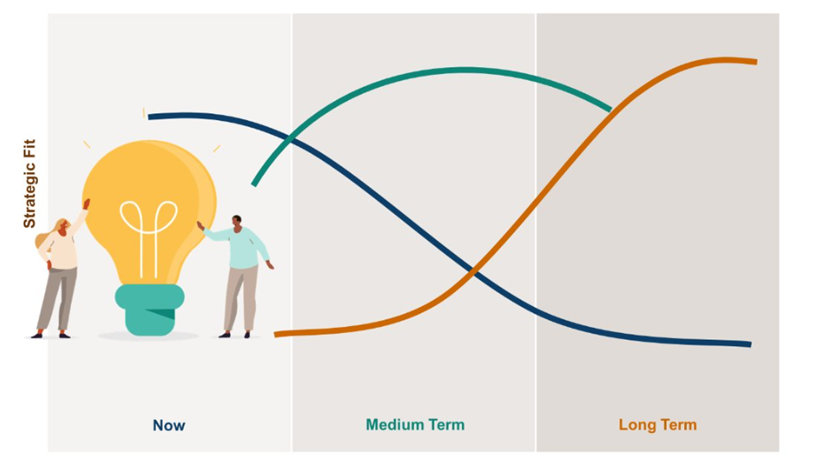Rethinking the Map:
Strategy and Evaluation in Systems Transformation
Written by: Mathilde Wennevold
What does it take to transform a system?
In a recent webinar in the Clear Horizon Ripple Effect series, three leading evaluation experts – Jess Dart (CEO of Clear Horizon), Mark Cabaj (Founder of Here 2 There Consulting), and Sarah Callaghan (Head of Networks and Insights at Collaboration for Impact) – tackled this question head-on in conversation with Kaitlyn Scannell (Lead principal, Clear Horizon). The result was a genuine and generous conversation about what strategy and evaluation look like when the goal is not reform, but transformation.
Here are five key takeaways that we hope will inspire anyone working at the messy edge of change.
Watch the full webinar here.
1. Transformation isn’t a bigger program. It’s a different game.
We tend to reach for systems language when things feel big or complex. But systems transformation is not just about scale, it’s about shifting the status quo, often at a foundational level.
As Jess Dart put it: “It’s not a program. It’s not a programmatic approach. It’s something else.”
She describes a systems transformation approach as taking a zoomed-out view—not just solving a problem in one place but understanding how that problem is held in place by deeper structures, patterns, and relationships. It’s a change that grips and sticks.
Mark Cabaj echoed this, drawing on the Three Horizons model:
“Incremental change is same game, same rules. Reform is same game, different rules. Systems transformation? That’s different game, different rules.”
This clarity helps practitioners avoid old traps, such as mistaking tweaks for shifts or metrics for meaning.
Insight: The Three Horizons model, developed by Bill Sharpe, helps us make sense of different kinds of change over time and what it takes to move from the present toward a fundamentally better future.
- Horizon 1 is the current system: what is dominant, embedded, and often no longer fit for purpose. It’s where we see stagnation or decline. (See the blue horizon in the image below.)
- Horizon 2 is the zone of innovation: where new ideas, practices, and experiments start bubbling up. It’s messy, contested, and full of possibility. (See the green horizon in the image below.)
- Horizon 3 is the preferred future: the transformed system we want to grow into. It’s often held by visionary thinkers and lived in small pockets before becoming mainstream. (See the orange horizon.)
2. Strategy is a practice of imagination, not certainty
Traditional strategy tools like SWOT analysis and five-year plans tend to fall short in complex change. Why? Because transformation isn’t linear. It’s emergent. Messy. Relational.
In this view, real strategy is not a fixed document but a living process.
“Strategy is also the day-to-day practices of making decisions,” said Sarah Callaghan, who leads strategy and insights at Collaboration for Impact. “And when we can’t fully see the future, we need to hold tight to purpose while everything else is shifting.”
She talked about pattern spotting: a technique for surfacing system-level trends, and the creative power of inviting new voices to reframe a problem.
“Maybe if we ask different people, we’ll find different ways to solve the problem,” she offered. “And that’s when systems transformation becomes possible.”
3. Evaluation should serve the work, not the other way around
What’s the role of evaluation in all this? Not to tick boxes. Not to produce pretty reports. Not to “prove impact” in 12-month cycles. In fact, if that’s your framing, you might be killing the very thing you’re trying to nurture.
“Evaluation should help change-makers do their work better—and do better work,” said Mark. “It’s not about reports. It’s about integrating insight into decision-making.”
He called for a shift from accountability-first to learning-first evaluation. That means asking real-time questions, sensemaking with stakeholders, and designing evaluations that are as adaptive as the strategies they’re supporting.
Jess added her own hard-earned lesson:
“I once spent nearly the entire budget rewriting the evaluation plan, because the strategy pivoted four times. Never again. Now I slow-cook the plan. Two pages. Principles. Then we iterate.”
4. You can’t transform systems without transforming yourself
Perhaps the most powerful thread in the conversation was this: transformation is not just technical—it’s personal.
“We’re so used to turning up as experts,” said Jess. “But the expert model is not so useful in systems transformation.”
They argued that systems work demands vulnerability, humility, and an ability to navigate discomfort, especially when power is challenged.
Sarah shared a poignant story about a First Nations participant who questioned his place in a cross-sector planning workshop. The room froze, but instead of moving on, the group made space. Others voiced discomfort. Dialogue unfolded. The work deepened.
“Where there’s resistance,” Sarah said, “there’s opportunity.”
Mark agreed:
“Run to resistance. It’s a terrific opportunity for learning.”
5. Zombie practices are everywhere. Let them die.
Finally, the group turned their sights on outdated practices that refuse to die, those not-so-affectionately named Zombie Practices. Jess named one straight away: linear, rigid planning.
“Waterfall planning doesn’t work in systems transformation. If you invest heavily in a fixed plan, expecting to execute it as-is, you’ll waste a lot of time.”
Mark tackled the obsession with dashboards and metrics:
“Most dashboards are a photocopy of a photocopy of reality that arrives late and is decontextualised. We need an exorcism.”
His call to arms: ditch metrics unless they’re embedded in context, shaped by story, and used by the people doing the work. “No numbers without narratives. No narratives without numbers.”
The Long Road is the Real Road
This webinar didn’t offer easy answers, but that’s the point. Systems transformation isn’t quick or clean, but it is possible when we slow down, learn together, and remember that small changes can matter and that resistance is not the enemy.
As Jess said: “You’ve got to let go of the expert role. Let go of the big plan. Let go of the dashboard-first mentality. And start showing up differently.”
The journey isn’t about being right; it’s about being real. Follow this link to watch the full webinar.
What’s next
Did this conversation spark your curiosity about how your evaluation work can help drive systems change? We invite you to join our next cohort of the online course Systems Transformation: Strategy and Evaluation to build your skills and confidence in this messy, emergent space.
Oh, and to make sure you don’t miss out on our next webinar, sign up to our mailing list to receive our monthly newsletter full of news, event details, exclusive offers, and industry insights.






